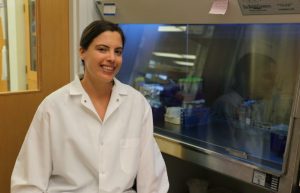Re-posted from August 8, 2019, UNC Information and Technology Services (ITS) website.
Customer Case Study
Kathryn Gunn is a post-doctoral researcher in the Neher Lab of the Biochemistry and Biophysics Department within the UNC-Chapel Hill School of Medicine. She is a new client of ITS Research Computing.

The Client
The Neher Lab in the School of Medicine’s Department of Biochemistry and Biophysics studies lipases — enzymes in blood that break down fats. Professor Saskia Neher directs graduate students and post-doctoral fellows in research to understand the function of lipases.
Gunn, a post-doctoral research associate from North Carolina, has been working in the Neher lab for two years. Her focus is studying and resolving the atomic structure of lipases: how the molecules are built and how they look.
In May of 2019, UNC-Chapel Hill acquired a cryo-electron microscope. An electron microscope (EM) is a microscope that uses accelerated electrons as a source of illumination. Electron microscopy enables researchers to obtain images of specimens at molecular resolution. A cryo-EM produces images of the individual molecules of the specimen frozen in vitreous ice and enables researchers to build three-dimensional models for the molecules they study from these images.
The University collaborates with Duke University and the National Institute for Environmental Health Science in the Molecular Microscopy Consortium (MMC).
The Challenge
When the University acquired a cryo-EM, Gunn needed to analyze the images with software, like Relion and EMAN2, which only run in Linux environments. Since the University was a member of the MMC, she was able to use the Linux machines at NIEHS, but it required a 20-minute commute. Because Gunn was not on site, she was unable to oversee the computations. A lot of time could pass between attempts to analyze the data sets if a technical error occurred and she was not on site.
Using GPUs is a recent innovation for electron microscopy because GPUs can quickly analyze the enormous data sets of images — an average data set is 1.5TB. The Biochemistry and Biophysics Department is considering purchasing GPUs for University use, but there are not GPUs available yet.
The Solution
Gunn reached out to ITS Research Computing to see if the division had any computing resources that could help her. Research Computing’s Jeff Roach “put me at the starting line, and I was actually able to get started,” she said.
Roach helped Gunn set up Google Cloud Platform accounts, use tools to queue workflows, install the specific software she needed, and move data from the Dogwood computing cluster to the cloud.
The Results
“Once he showed me how to start the account, I was able to use it and solve the structure, and we’ve been so happy with what he’s been able to do for us. We’ve recommended it to other people interested in cryo-EM at UNC,” Gunn said.
Even if GPUs are purchased for the School of Medicine research use, cloud computing is a great resource for researchers who only need GPUs occasionally. The rest of Gunn’s lab has also benefitted from access to the cloud.
“We’d never had mass storage, and now we’re storing terabytes of data,” she said.
The Future
ITS Research Computing has been supporting and empowering cloud computing for researchers at UNC-Chapel Hill. Gunn attended and found value in a workshop that Research Computing organized for researchers to learn about Google resources. By supporting cloud computing, Research Computing is empowering researchers to expand their potential.
Story courtesy of UNC ITS.
